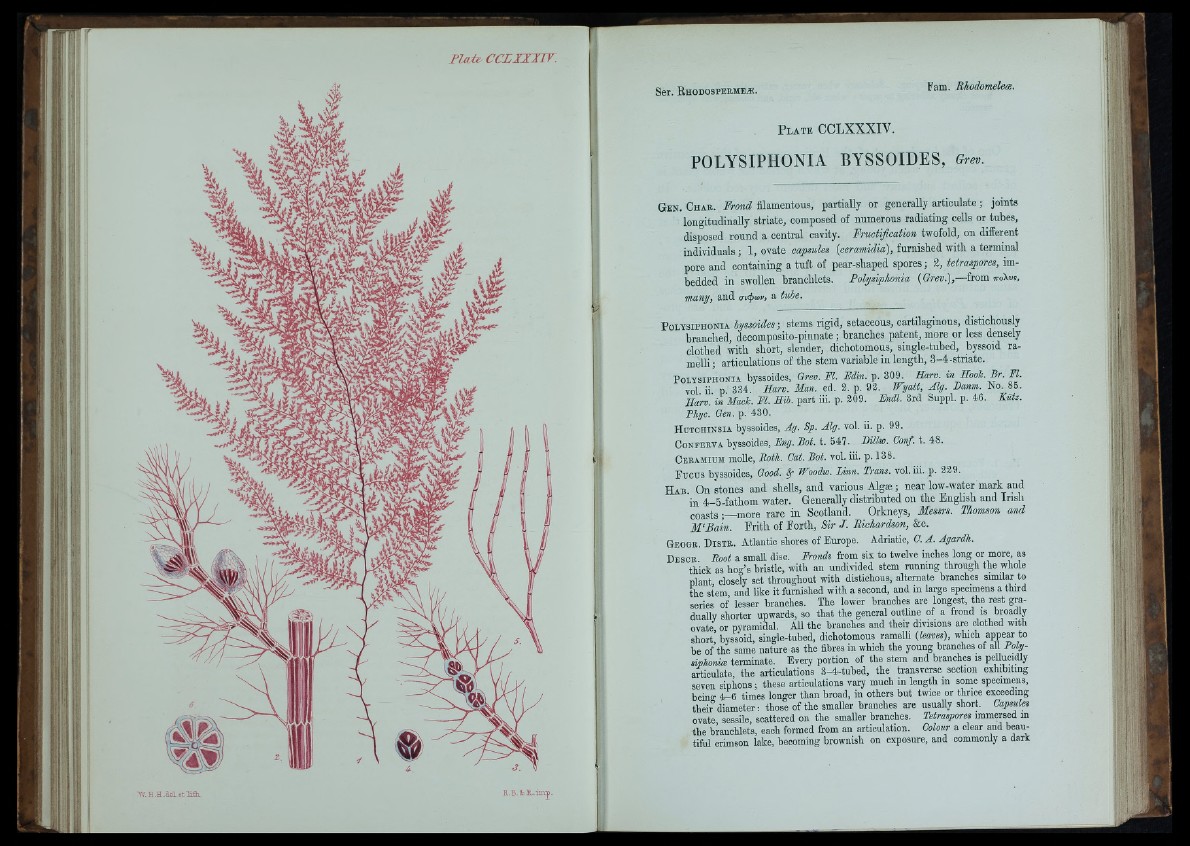
I
P l a t e CCLXXXIV.
POLYSIPHONIA BYSSOIDLS, Grev.
G e n . Ch a e . Frond filamentous, partiaUy or generaUy articulate; joints
longitudinaUy striate, composed of numerous radiating cells or tubes,
disposed round a central cavity. Fructification twofold, on different
individuals ; 1, ovate capsules {ceramidia), furnished with a terminal
pore and containing a tuft of pear-shaped spores; 3, tetraspores, imbedded
in swoUen branchlets. Polysiphonia ((?««>.),—from ttoX«?,
, and trtfiev, a tube.
P o l y s i p h o n i a byssoides; stems rigid, setaceous, cartilaginous, distichously
branched, decomposito-pinnate ; branches patent, more or less densely
clothed with short, slender, dichotomous, single-tubed, byssoid ramelli;
articulations of the stem variable in length, 3-4,-striate.
P o l y s i p h o n ia byssoides, Qrev. FI. M in . p. 309. Earv. in Hook. Br. FI.
vol ii p 334. Harv. Man. ed, 2. p. 92. Wyatt, Alg. Banm. No. 85.
Earv. in Mack. FI. Eih. part hi. p. 209. Endl. 3rd Suppl. p. 46. Kütz.
Phyc. Gen. p. 430.
H u t c h i n s i a byssoides, Ag. Sp. Alg. vol. ii. p. 99.
C oN F E K V A b y s s o i d e s , Eng. Bot. t . 547. Billw. Conf. t . 48.
Ceeamium molle, Both. Cat. Bot. vol. iii. p. 138.
Puous byssoides. Good. Woodw. Linn. Trans, vol.ih. p. 229.
H ab On stones and shells, and various Algæ ; near low-water mark and
in 4-5-fathom water. GeneraUy distributed on the English and Irish
coasts more rare in Scotland. Orkneys, Messrs. Thomson and
M 'B a in . Frith of Forth, Sir J. Richardson, &e.
G e o g k . D i s t e . Atlantic shores of Europe. Adriatic, 0. A . Agardh.
D e s c e Boot a small disc. Fronds from six to twelve inches long or more, as
thick as hoo-’s bristle, with an undivided stem running through the whole
plant closely set thi-oughout with distichous, alternate branches similar to
the stem and like it furnished with a second, and in large specimens a third
series of lesser branches. The lower branches are longest, the rest gradually
shorter upwards, so that the general outline of a frond is broadly
ovate or pyramidal. AU the branches and their divisions are clothed with
short’ byssoid, single-tubed, dichotomous ramelli {leaves), which appear to
be of the «ame nature as the fibres in which the young branches of all Poly-
siphonim terminate. Every portion of the stem and branches is pelluciiUy
articulate, the articulations 3-4-tubed, the transverse section exhibiting
seven siphons ; these articulations vary much in length in some specimens,
beino- 4 -6 times longer than broad, in others but twice or thrice exceeding
their* diameter • those of the smaUer branches are usuaUy short. Capsules
ovate sessile, scattered on the smaUer branches. Tetraspores immersed m
the brauchlets, each formed from an articulation. Colour a clear a^nd beautiful
crimson lake, becoming brownish on exposure, and commonly a dark